
I love bridges. I love to look at them, walk or drive across them, think about their history, and ponder their significance. Scotland has some of the UK’s most beautiful and interesting bridges, and we’re going to be able to see several of them on our travels. Driving around the country, I sometimes think the Scots built bridges just for the fun of it, whether or not they needed to get from one place to the next.
The most famous of all the bridges in Scotland is probably Glenfinnan Viaduct crossing the Finnan River in Inverness-shire—which is sadly not on our itinerary. I can’t resist talking about it, though, because it is both an architectural wonder and a jaw-dropping sight. The bridge opened in 1901 and is 416 yards long. Set in a lush river valley, it has twenty-one semicircular spans of fifty feet that curve slightly. Imposing and elegant, Glenfinnan Viaduct owes its fame not only to engineering brilliance, but also to the work of Scotland’s most famous writer, J. K. Rowling and the film versions of her Harry Potter books. The train to and from Hogwarts School of Witchcraft and Wizardry chugs along the bridge, billows of steam pouring romantically–if anachronistically–from its smokestacks.
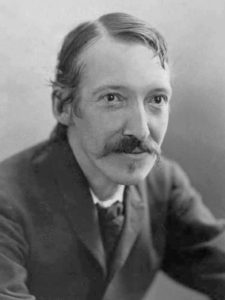
Scottish bridges are legendary and not just because of Harry Potter. A country with as many rivers, firths (estuaries), and lochs (lakes) as Scotland has—some of them very inconveniently situated—was bound to need ways to cross them. Long known for their ingenuity, Scots built amazing bridges for centuries before civil engineering became a recognized and important science at their universities in the second half of the nineteenth century. After that, there was no holding them back. The natural scenery of Scotland is stunning almost everywhere, but man-made bridges throughout the country add to that grandeur by showing us the web of human aspiration and connection laid over the landscape.
Brig O’Doon
We’ve already discussed another bridge made famous by a writer, Brig O’ Doon in Alloway, the bridge across which Robert Burns’s Tam O’ Shanter rode on his wild night ride through the countryside chased by witches. We’ll see this bridge and be able to walk across it when we visit Burns’s birthplace. The setting—a lovely garden and wooded banks—and the stunning single arch of the bridge spanning the River Doon create the magic that is Brig O’ Doon.
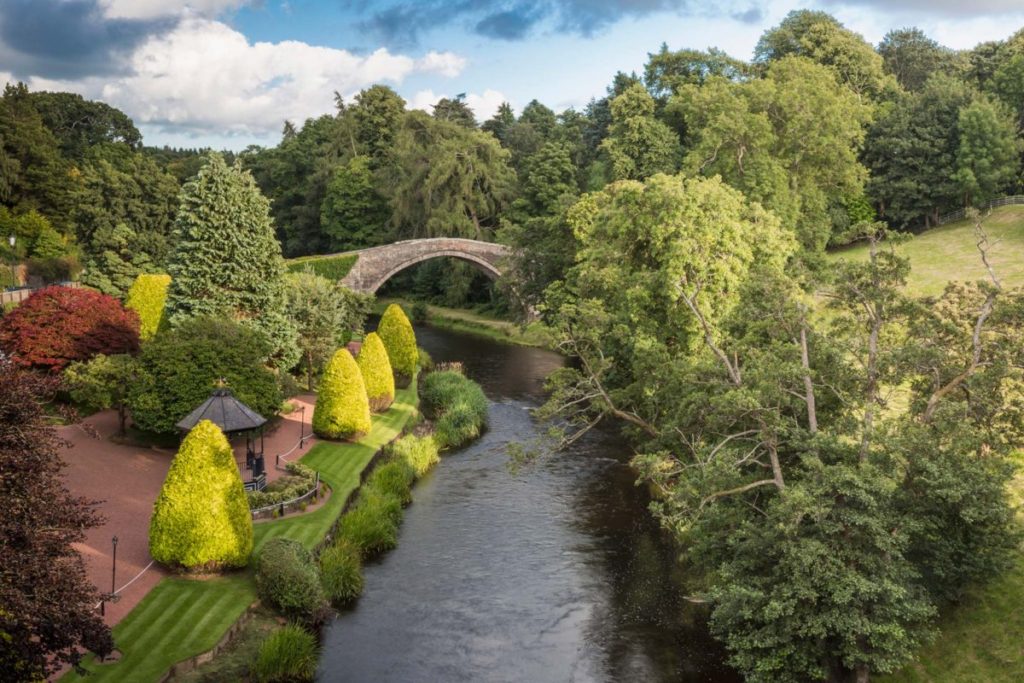
The real Brig O’ Doon, sometimes called “the Auld Bridge,” was built in the early fifteenth century and has been ruined and rebuilt several times. It is said that the uneven cobblestones on the span are set awry to stop witches from crossing. As early as 1816, traffic was diverted from the bridge to another nearby as it was just too crowded. As you may have guessed, Alan Jay Lerner and Frederick Loewe derived the name of their mythical Scottish village in the eponymous musical Brigadoon from Burns’s beloved bridge (click here to listen to the title song “Brigadoon”).
The Twa Brigs O’ Ayr
Not far (.7 miles) from the hotel where we’ll be staying in Ayr, the “Twa Brigs O’ Ayr” stretch across the river of the same name. The “Auld Brig” was built in the late sixteenth century on the site of an earlier structure and has three broad arches. It was repaired and rebuilt many times after that. The earliest bridge at this point is said to have been founded by two sisters after the suitor of one drowned while attempting to ford the river. The Old Bridge is today a pedestrian crossing, the fate of so many of the older structures and a boon for today’s tourists and walkers.

Just up the River Ayr to the northwest, the New Bridge was first built in 1789. Robert Burns knew the Old Bridge and the original New Bridge well and wrote a famous poem about them, “The Brigs of Ayr” (click here to read the poem in its entirety). In the poem, the two bridges argue with each other over which one of them is better and will endure. Here’s a sample of the debate between the Auld Brig and the New Brig in Burns’s poem.
The New Brig
There’s men of taste wou’d tak the Ducat stream,
Tho’ they should cast the very sark and swim,
E’er they would grate their feelings wi’ the view
O’ sic an ugly, Gothic hulk as you.”The Auld Brig
“Conceited gowk! puff’d up wi’ windy pride!
This mony a year I’ve stood the flood an’ tide;
And tho’ wi’ crazy eild I’m sair forfairn ,
I’ll be a brig when ye’re a shapeless cairn!

Prescient in this as in so many things, Burns foresaw the shoddy nature of some “modern” construction. The New Bridge of 1789 was destroyed by repeated flooding, and the new New Bridge replaced it in 1878. Today you can enjoy the two structures together on a walk through the Ayr city centre.
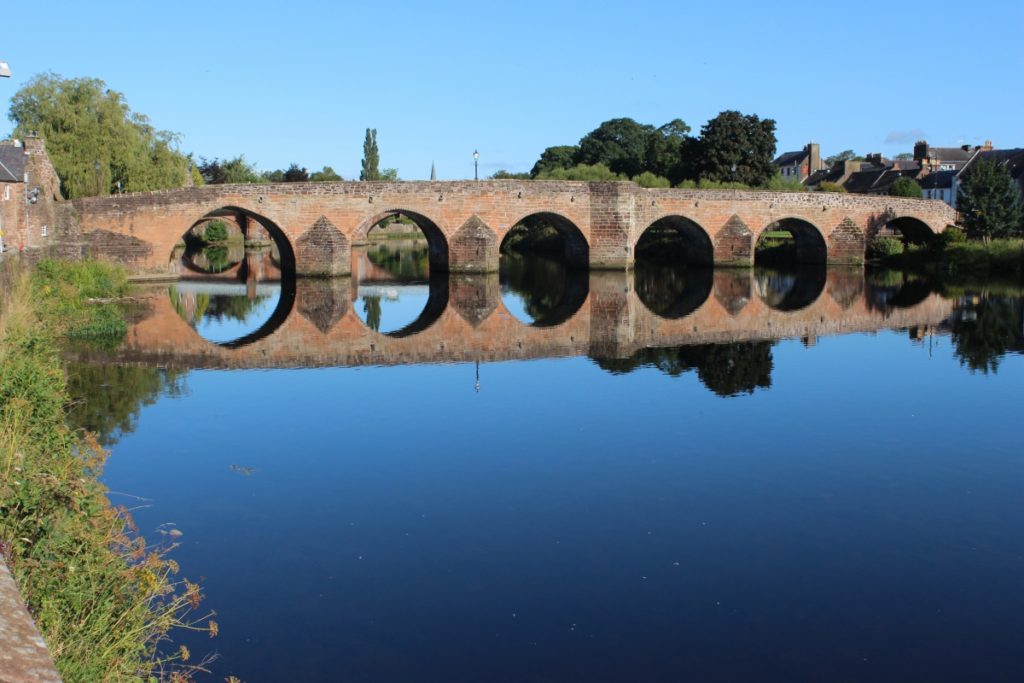
Devorgilla Bridge
When we’re visiting Burns’s house and tomb in Dumfries, we will be a short walk from Devorgilla Bridge, one of the oldest still in use in Scotland. Built in the early 1600s on the site of several earlier bridges across the River Nith, the bridge justifies our tendency to call structures like this “she”: Devorgilla, Lady of Galloway, was the mother of King John Balliol of Scotland and the patron of the first bridge here in the thirteenth century. She must have been a formidable woman. Balliol College at Oxford is named after Devorgilla’s huband, but she provided the endowment upon his death and formulated the college statutes. Built of the red stone used in the area, this sturdy but remarkably graceful structure stretches across the river in six semi-circular arches, down from nine because the river narrowed over time. The bridge house still stands on the far side. Burns himself would have walked across the bridge, as people do today. The view of the town of Dumfries from the bridge takes us back to an older world.
Leaderfoot Viaduct
With its tall (126 feet), graceful arches, Leaderfoot Viaduct near Melrose is clearly a more modern achievement. When you come upon it reaching across the River Tweed in the green hills around Melrose, your heart soars. Melrose resident Sir Walter Scott died twenty-two years before it was built, but I believe he would have approved. It was opened in 1863 during the boom era for bridge building and the railways.
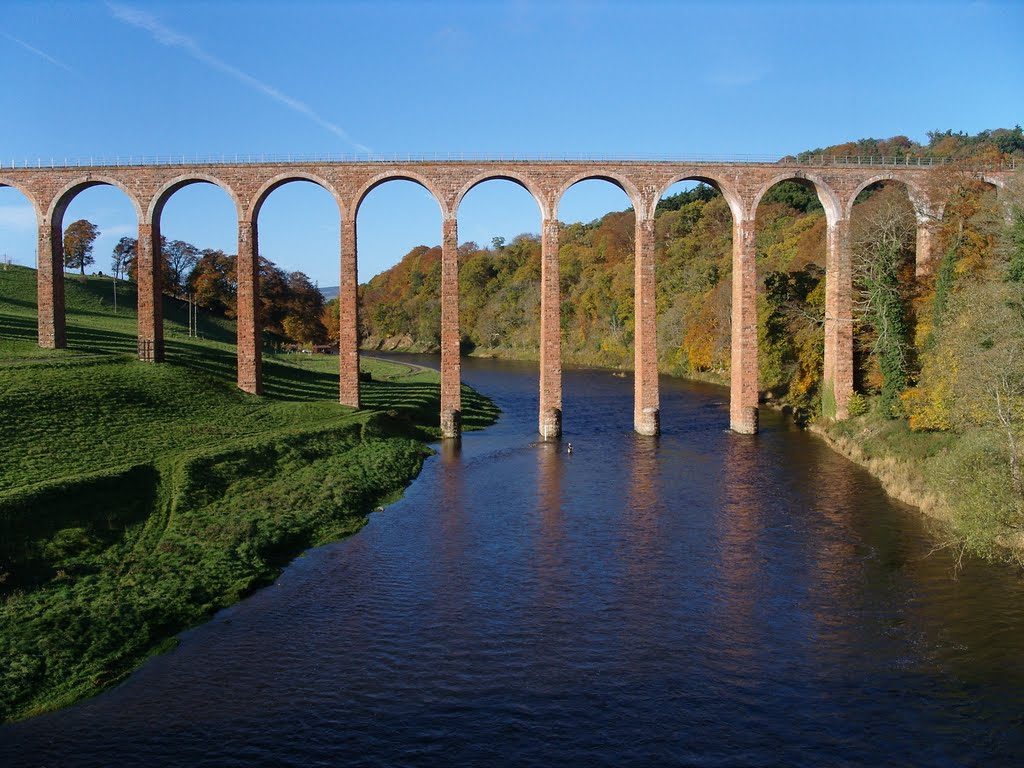
Like Glenfinnan Viaduct, which it resembles, Leaderfoot Viaduct (sometimes called Drygrange Viaduct) was built for the railway. These dramatic railroad bridges of yesteryear speak for the ambition of their designers and illustrate a grand idea about the industrial revolution and how it would change the countryside. No such feat would be attempted in this remote place today, and indeed, the viaduct was almost pulled down in 1981 when it seemed to be beyond repair. Now in the stewardship of Historic Scotland, a government agency concerned with heritage (now Historic Environment Scotland), the bridge draws tourists, bridge and train enthusiasts, and wedding photographers. Two nearby rivers, the Tweed and the Leader, often flood the valley in which the viaduct stands, adding to the need for constant maintenance. Today, Leaderfoot Viaduct no longer bears the railway, but Historic Scotland has created a walkway that is open to the public, weather permitting .

The Three Bridges: Three Bridges Spanning Three Centuries
The Three Bridges across the Firth of Forth near Edinburgh area are one of Scotland’s most stunning sights. Even the aerial photographs don’t do justice to the awe you feel looking up at them from the shore at South Queensferry. Built at this logical crossing point over more than a hundred years at one of the busiest places in Scotland, these edifices together offer a crash course in civil engineering.
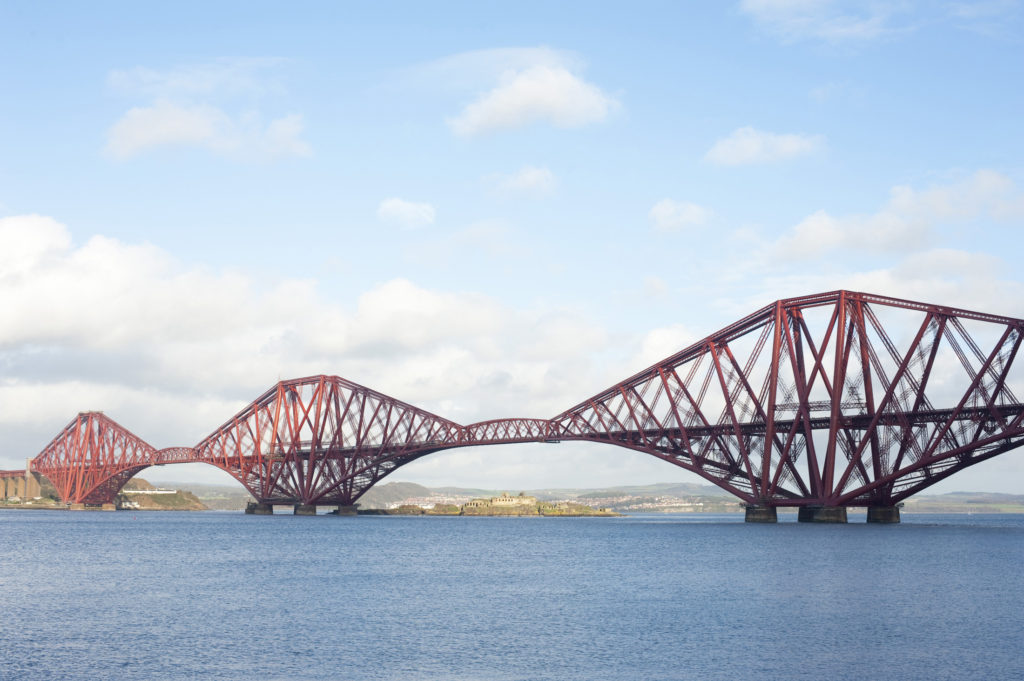
The Forth Bridge, sometimes called the Forth Rail Bridge, started it all in 1890, at that time the longest single cantilever bridge span in the world and the first such structure in the UK to be made of steel. Up until then, ferries had been the only way to cross the Firth. A tunnel was proposed in 1806 but proved unfeasible. Several attempts to design a bridge that could withstand the weather and tidal conditions of the area came to nothing. Given that the structure would need to carry the railway, a suspension bridge was ruled out. A cantilever design by the engineers Sir John Fowler and Sir Benjamin Baker was finally chosen and took eight years to complete. Bridge and train enthusiasts from all over the world come to South Queensferry to see it. The three cantilever structures, each with four towers, and the brick red color make the Forth Bridge stand out dramatically against the blue-gray water of the firth.
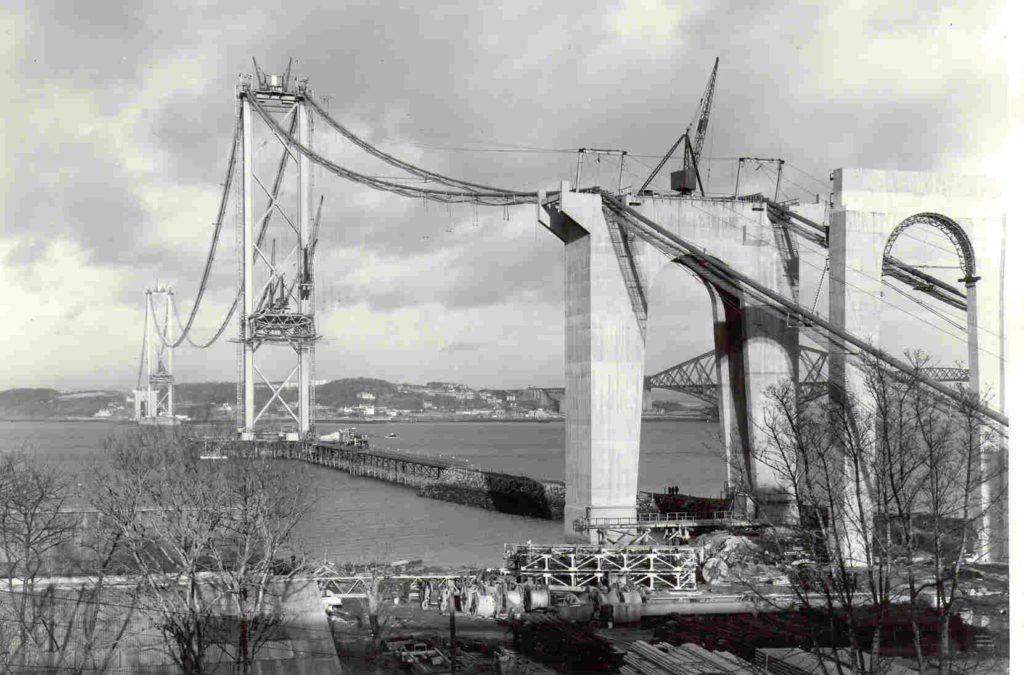
The Forth Road Bridge just west of the rail bridge is a long span suspension bridge built in 1964, the first of its kind in the UK at the time. The Firth of Forth cuts deeply into Scotland just north of Edinburgh, and before this bridge was built, if you wanted to go from north to south by car you had to go around the firth or take a ferry. The reality of the age of the automobile finally necessitated a road bridge at South Queensferry. Over a mile and half long, the bridge served all traffic for over fifty years but now carries buses, taxis, and motorcycles and has a path for pedestrians and bicycles. The bridge has a motto in the Scots language, “Guid Passage”: no translation needed.
Queensferry Crossing, a three tower cable-stayed bridge spanning the Firth of Forth, the longest such bridge in the world, opened in 2017. It crosses the firth just to the west of the Forth Road Bridge and was constructed to relieve the heavy-load traffic that was already causing damage to its sister bridge. The M90—the main route north to the Highlands from Edinburgh—is routed across this bridge, The new bridge uses 23,000 miles of cable and suggests a magnificently strung tripartite harp. On the occasion of the opening of the Queensferry Crossing, Malcolm Roughead, Chief Executive of VisitScotland, said
Scotland will celebrate a moment in history on 4 September as the Queensferry Crossing is officially opened by HM The Queen. At this unique moment, the country will become the world’s first destination to have three bridges spanning three centuries in one stunning location. It is a time to not only celebrate Scotland as a nation of pioneering innovation, design and engineering, but also give thanks all those who have worked tirelessly to create this unique new structure.

They may be just ways of getting from one place to another, but the Brigs O’ Scotland tell a compelling story of vision, ingenuity, and persistence, a story that is many centuries old.

Photo ops abound! We have at least one civil engineer aboard who will enjoy these tremendously! I’m reading Myself & The Other Fellow, a bio on Robert Louis Stevenson. The family’s lighthouse legacy is really interesting.
Great–maybe he can explain the physics behind the various bridge features!
I enjoyed Waverly so much I have started Rob Roy! The audio is great. My poor husband is now going to have to take a small detour on our way to Skye to see his grave…..
The movie with the wonderful Liam Neeson as Rob Roy is fun, but deviates from the book, of course!
Oops! Looks as if now we must add the Glenfinnan Viaduct also on our detour!
Years ago, I played Jane Austin (and a resident of Brigadoon) in CA, a community theatre. Let’s hope I don’t break out in song and dance when I see the real thing!